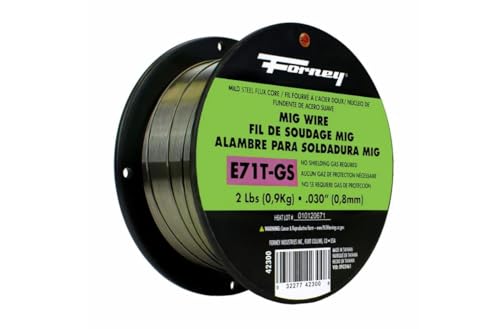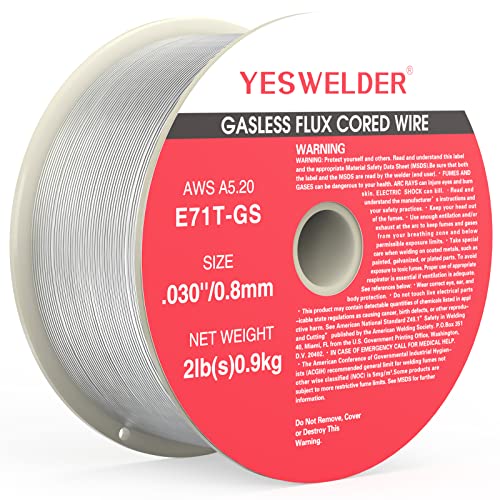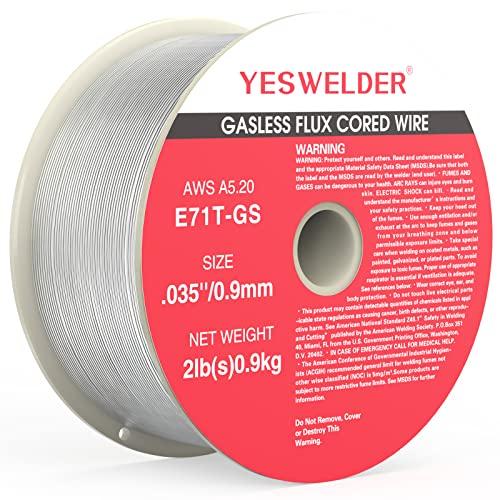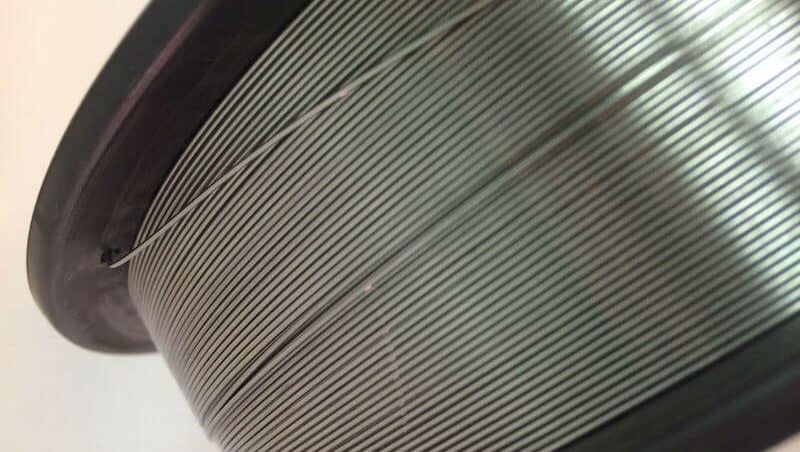Besides your skill level, wire is the single biggest factor in flux core welding quality.
There’s no way around it. Great skills matter, but real results need good wire.
But who can afford experiments when your living is on the line?
Not to worry. We went to the trouble, finding five flux core wires that deliver clean welds.
Let’s take a look, shall we?
In a Rush?
Here's 3 products we picked out that thought you would be interested in depending on your budget...
The Best Flux Core Wire With Reviews
We've checked across the market to find five flux core wires just for you.
1. Hobart Fabshield E71T-11 .030 Welding Wire

- Carbon steel welding wire
- Good on thin sheet metal
- Use on galvanized steel
- 2-pound roll
- 0.030-inch diameter
Pros
- All position MIG wire
- Works well on rusty, dirty or painted steel
- Excellent for outdoor welding
- High speed when used for single pass work
- Hotter than solid wires
Cons
- Complaints of a lot of spatter
- Reports of badly wound spools
Overview
Hobart Fabshield E71T-11 is a .030-inch diameter flux core welding wire with high tensile strength. This wire is useful for welding in multiple position work and out of position welding as opposed to straight horizontal welds. Even in the .030 diameter it’s known to need more heat than other brands to get the same penetration. This is because Hobart chooses to go with a harder steel for the base metal in this wire.
There are complaints from users about excessive splatter, but the answers from Hobart’s tech support recommends higher amperage to get better penetration. The deeper penetration burns away spattering droplets more completely. Another common complaint is with the spools either coming unspooled when the package is first opened or not unwinding well when they’re being fed out from the machine. This is actually a common problem with all spools of flux core wire.
E71T-1 wire is the most versatile self shielded flux core wire you can buy. The wires Hobart designs to feed through its welders are high quality and we’ve selected the Hobart Fabshield E71T-11 .030 as Our Favorite choice.
2. Forney E71T-GS .030 Flux Core MIG Wire

- E71T-11 wire
- Suited for sheet metal or plate
- Welds galvanized steel
- 2-pound wire spool
- .030 diameter wire
Pros
- Multiple position wire
- Use for painted or rusty metal
- Works in breezy conditions
- Can weld single pass at high speed
- This is a hot wire
Cons
- Some feeding problems reported
Overview
Forney E71T-GS is a self-shielding flux core wire. This particular model number is .030-inch diameter. It’s intended for welding in all positions and is a high tensile strength wire with 79,000 PSI. Forney points out that this wire produces low to moderate spatter and recommends using an Argon/CO2 gas mix on MIG welders to reduce spatter. Higher amperage settings can also help with this.
There are numerous reports from users that this wire can break or comes with too much manufacturing coating on it. Some users have installed wire cleaners on their welding machines to fight this issue. There are also some reports of this wire not feeding smoothly in Lincoln welders. Like most welding wire, it’s easy to find complaints of spools becoming tangled or unwinding improperly, but these problems usually can be traced to cheap or improperly adjusted feed mechanisms, dirty wire or a gun liner that needs replacing.
Overall, this wire has a lot of satisfied users, especially among Forney and Hobart owners. It also provides great results in Harbor Freight machines.
3. Lincoln Innershield NR-211-MP .035 MIG Wire

- 0.035-inch diameter
- High tensile strength E71T-11
- Great bead appearance
- Use on galvanized steel
- 1-pound wire spool
Pros
- Welds up to 5/16-inch plate
- Good for painted and rusty metal
- Intended for outdoor welding
- Easy slag removal
- Fast freeze puddle
Cons
- 1-pound spool instead of 2 pounds
- Some quality control issues
Overview
The Lincoln Innershield NR-211-MP flux core wire is a .035-inch diameter wire that’s able to weld up to 5/16-inch thick plate with good penetration. This wire is designed to be used on coated, galvanized, painted or rusty metal with good results. Like most flux core wire, it’s a good choice to use for outdoor welding because it’s resistant to breezes. This wire is more expensive than the others in this guide because it comes in a 1-pound spool instead of 2 pounds. Lincoln designed this flux core welding wire for easy slag removal.
The fast freezing characteristics of Lincoln Innershield flux core wire makes it outstanding for welding in out of position situations, vertical or overhead welding and when you need to weld joints that have poor fitment. The Lincoln Innershield NR-211-MP flux core wire is known for a great bead appearance and easy feeding. Some users have reported wire breakage and there are some reports of wire splits or kinks, but these issues don’t seem to be very common.
4. Yeswelder E71T-GS .030 Welding Wire

- For welding out of position
- Self shielded welding wire
- Carbon and manganese steel
- 2-pound spool
- 0.030-inch flux core wire
Pros
- Low spatter production
- Rusty, painted or galvanized steel
- Easy slag removal
- Porosity free welding wire
- Good bead formation
Cons
- Won’t spec for US or EU gov jobs
Overview
Yeswelder E71T-GS is intended for all position welding. Users report low spatter from this self-shielding flux core wire and high praise for its bead appearance. Yeswelder E71T-GS is designed to be welded over in multiple passes and has easily removable slag, making it good for beginners and in production sheet metal work. One of the biggest problems when welding sheet metal is blowing through the metal.
This can be helped by running tack welds every so often along the seam, then going back over and running more tacks on an intermittent basis. This lets the original welds cool off before coming back to that area of sheet metal. The fact that you can weld over a previous pass lets you overlap to create a complete run just a stitch at a time, then grind it down. Users report that this wire produces easily grindable beads as well, making it well-suited for this work.
This is a .030-inch diameter mild steel wire. One potential issue with Yeswelder E71T-GS is that it’s made in Hong Kong and therefore can’t meet certification standards on U.S. and E.U. government jobs.
5. Blue Demon E71T-GS .035 Flux Cored Welding Wire

- Wire diameter .035 inch
- Welds up to 3/8-inch plate
- Single or multipass welding
- Suitable for galvanized steel
- 2-pound roll
Pros
- Good slag coverage, easy removal
- Produces beautiful beads
- Welds well on dirty or painted steel
- Great outdoor shielding, low smoke
- Good gap coverage on sheet metal
Cons
- Some users report excessive spatter
- Complaints with feeding in Big 3 machines
Overview
Blue Demon E71T-GS .035 Flux Core Wire is a self-shielded mild steel wire suitable for both carbon and manganese steels. It’s able to do both single pass and multiple pass welding. It’s good for jobs like sheet metal stitch welding or for filling gaps on pieces with poor fitment. With easy slag removal, it’s well suited to multiple pass welding.
This wire does single pass welding with good penetration on up to 5/16-inch plate thickness. Users report great bead appearance and easy feeding, but there are frequent complaints of feeding problems on big name welders like Lincoln, Hobart and Forney machines. This is probably because of precision MIG-based solid wire feeder designs, which often don’t use the knurled feed rollers found on flux core machines. Many users complain of high spatter amounts from this wire.
Although the Blue Demon E71T-GS wire is generally of high quality, because it’s manufactured in China you can’t use it for government work in the United States or Europe. With uneven performance from machine to machine, it’s advisable to try it first before you buy it, if you can.
Buyer’s Guide
Gas-shielded flux core wire was introduced in 1957, followed in 1961 by self-shielded wires. All of the flux core wires in this guide are self-shielded wires that don’t require gas. These wires are great for use in simple, inexpensive wire feed welding machines that don’t have gas hookups.
AWS Flux Core Wire Classification System
The classification system for flux core wire was established by the American Welding Society and looks like this:
E – Means electrode wire.
7 – This digit indicates tensile strength x 10,000 PSI or 70K PSI
1 – indicates all-position wire, and 0 means flat and horizontal positions.
T – means tubular or flux core wire.
1 – All the wires in this guide use a 1 here. It refers to settings and methods.
1 – Means self-shielded wire. C means CO2, and M means gas mixture.
Reasons for Flux Core VS Solid MIG Wire
E71T-11 wire has the best performance for high volume, fast-paced production environments and requires less skill to use. When welding vertically, its fast freezing characteristics provide the fastest metal deposition rates, up to 7 pounds of steel per hour in automatic systems. E71T-11 is the most-used welding wire globally, common in shipbuilding, structural steel, and fabrication.
The ability to put different chemical mixes into tubular wire creates performance enhancements over solid wire. There are slag forming materials that shield the weld pool from porosity and help to support the weld puddle when welding vertically. Metal powders such as alloys to increase mechanical strength and iron to improve metal deposition rate make for stronger, cleaner welds on rusty or scaly materials.
Welding Wire Diameter
The factors that affect the choice of flux core wire diameter include the type of feed wheels in your machine and the size of the nozzle tips in the MIG gun. There are also process factors to consider, like amperage settings and material thickness. Smaller diameter wires will require lower amperage rates for good results. The higher amperage rates associated with larger diameters can result in burn through, requiring higher feed rates to make up for the heat.
Read: Difference between .030 and .035 flux core wire
What Are You Welding?
Depending on your application, different wires may weld differently, even with an identical AWS classification. Wires by different brands don’t have the same alloy mix nor the same chemicals and ratios in the flux core mixture. There will also be less consistent quality from spool to spool with the inexpensive brands because many don’t make their own wire, they order it in, and each lot could be made by a different manufacturer.
By contrast, the industry-leading American and European names make their own wire with more consistent quality. For instance, Lincoln wire is generally considered very high quality but can cost significantly more because of expensive quality control processes to maintain consistency from roll to roll. Be sure to buy stainless wire for stainless steel, aluminum wire for aluminum, and carbon wire for mild steel. Try some before you buy it any time you can because some perform better on dirty or painted materials than other brands do. Spatter amounts can differ with the same wire on different welding machines.
Welding Machine Factors
Some professional-grade MIG welders have precision feeding mechanisms with smoothly finished grooved wheels for feeding solid wire to use with gas shielding. Some inexpensive wires don’t feed well in these machines. It can be worthwhile to change the feed rollers for a flat profile with knurled surfaces for a higher grip. The size of a spool your welder can fit is also something to keep in mind.
The Final Word
With everything taken into account, including spatter production, feeding concerns by users, and cost of the wire, we’ve chosen Hobart Fabshield .030 E71T-11 as Our Favorite.
We’ve gone with the Forney E71T-GS 0.030 Flux Core Wire as our Pro Value for this guide because it gives an excellent performance, high strength, and out-of-position welding for a reasonable cost.
